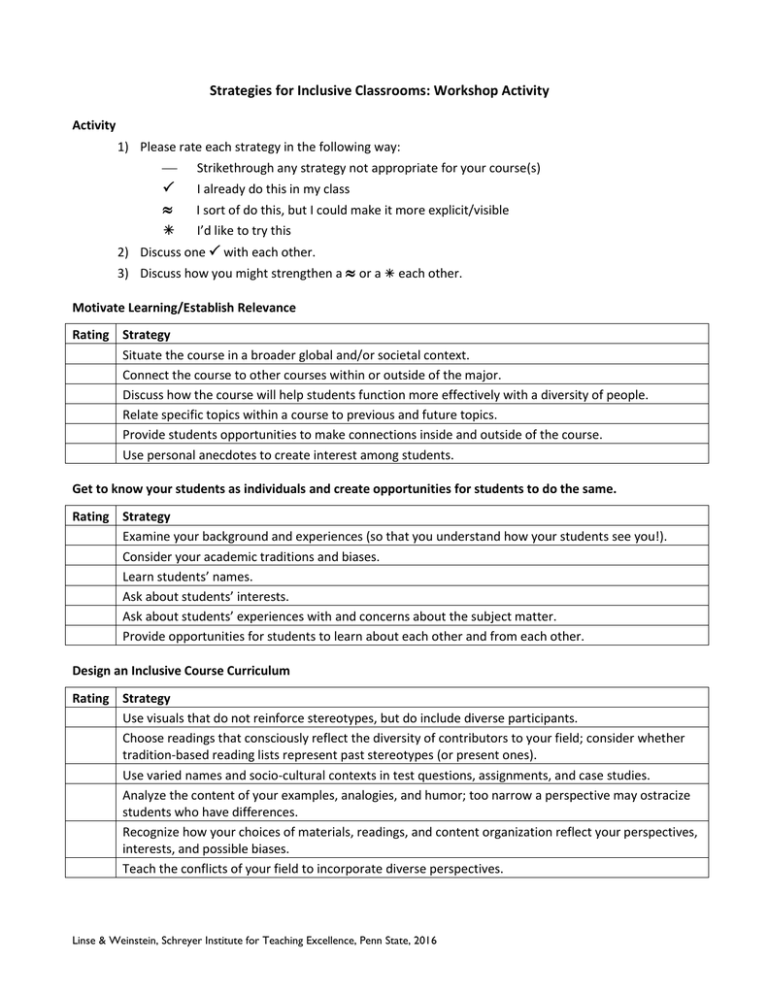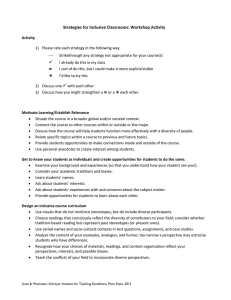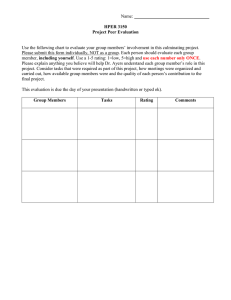AAC&U Inclusive Teaching Strategies 2016
advertisement

Strategies for Inclusive Classrooms: Workshop Activity Activity 1) Please rate each strategy in the following way: Strikethrough any strategy not appropriate for your course(s) I already do this in my class I sort of do this, but I could make it more explicit/visible I’d like to try this 2) Discuss one with each other. 3) Discuss how you might strengthen a or a each other. Motivate Learning/Establish Relevance Rating Strategy Situate the course in a broader global and/or societal context. Connect the course to other courses within or outside of the major. Discuss how the course will help students function more effectively with a diversity of people. Relate specific topics within a course to previous and future topics. Provide students opportunities to make connections inside and outside of the course. Use personal anecdotes to create interest among students. Get to know your students as individuals and create opportunities for students to do the same. Rating Strategy Examine your background and experiences (so that you understand how your students see you!). Consider your academic traditions and biases. Learn students’ names. Ask about students’ interests. Ask about students’ experiences with and concerns about the subject matter. Provide opportunities for students to learn about each other and from each other. Design an Inclusive Course Curriculum Rating Strategy Use visuals that do not reinforce stereotypes, but do include diverse participants. Choose readings that consciously reflect the diversity of contributors to your field; consider whether tradition-based reading lists represent past stereotypes (or present ones). Use varied names and socio-cultural contexts in test questions, assignments, and case studies. Analyze the content of your examples, analogies, and humor; too narrow a perspective may ostracize students who have differences. Recognize how your choices of materials, readings, and content organization reflect your perspectives, interests, and possible biases. Teach the conflicts of your field to incorporate diverse perspectives. Linse & Weinstein, Schreyer Institute for Teaching Excellence, Penn State, 2016 Create an Inclusive Course Environment Rating Strategy Set high standards and communicate your confidence that each student can achieve them. Let your students know that you believe each has important contributions to make. Applaud creative solutions and sincere efforts to learn. Help students understand that intelligence is not a fixed ability, not all academic challenges are a result of personal inadequacies, and many academic challenges can be overcome. Talk to students about how they learn best and how to adopt compensatory strategies. Do not ask or expect students to represent an entire group, either by look or by request. Encourage multiple perspectives (as opposed to consensus) in discussions. Establish ground rules. Use a variety of strategies to encourage contributions and to reduce over-participation by verbally assertive students. Create a culture of shared-purpose by periodically collecting feedback to learn how students are experiencing your course. Avoid assuming that a student needs assistance, which can convey that you have low expectations and further hinder their learning. Do not ignore or change the subject when students voice negative comments about a group. Make diversity and the free-exchange of ideas an early discussion topic. Do your best to correctly pronounce the names of your students. Avoid religious holidays when scheduling tests. Avoid expressing racially charged political opinions. Do not ask individuals with hidden disabilities to identify themselves in class. Avoid assuming the gender of any student. Do not assume all students speak English fluently. Ensure that the physical classroom space is inclusive for all students; e.g. are students who are alternately-abled marginalized in some way? Teach Inclusively Rating Strategy Use a variety of teaching methods; do not rely solely on lectures and didactic questions. Use pictures, schematics, graphs, simple sketches, films, and demonstrations. Provide a balance of concrete information (facts, data, real or hypothetical experiments) and abstract concepts (principles, theories, models). Balance material that emphasizes practical problem-solving methods with that emphasizing fundamental understanding. Provide brief intervals during class for students to think about what they have heard, seen, and learned. Provide opportunities for students to use or apply the course material/content. Have students work on class activities in pairs, triads, or small groups. Assign group membership randomly. Do not allow students to choose their own groups. Allow students to work on projects that explore their own social identities. Linse & Weinstein, Schreyer Institute for Teaching Excellence, Penn State, 2016 Provide Varied Opportunities for Success/Achievement Rating Strategy Allow students to accumulate grade points in a variety of ways. Allow students to select the weighting of different aspects of the course. Provide explicit information about your grading criteria using matrices or rubrics. Allow students to collaborate/cooperate on homework and class assignments. Offer a variety of ways for students to participate in class other than speaking aloud. Linse & Weinstein, Schreyer Institute for Teaching Excellence, Penn State, 2016



